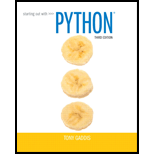
Concept explainers
Ackermann's Function
Ackermann's Function is a recursive mathematical
If m = 0 then return n + 1
If n = 0 then return ackermann (m - 1, 1)
Otherwise, return ackermann (m - 1, ackermann (m, n - 1))
Once you've designed your function, test it by calling it with small values for m and n.
Want to see the full answer?
Check out a sample textbook solution
Chapter 12 Solutions
Starting Out with Python (3rd Edition)
Additional Engineering Textbook Solutions
Starting Out with Programming Logic and Design (4th Edition)
Web Development and Design Foundations with HTML5 (9th Edition) (What's New in Computer Science)
Experiencing MIS
Web Development and Design Foundations with HTML5 (8th Edition)
Java: An Introduction to Problem Solving and Programming (8th Edition)
Starting Out with Java: From Control Structures through Data Structures (3rd Edition)
- Write a recursive function that returns the nth Fibonacci number from the Fibonacciseries.int fib(int n);arrow_forwardWrite a recursive function to generate nth fibonacci term in C programming. How to generate nth fibonacci term in C programming using recursion. Logic to find nth Fibonacci term using recursion in C programming. Fibonacci series is a series of numbers where the current number is the sum of previous two terms. For Example: 0, 1, 1, 2, 3, 5, 8, 13, 21, ... , (n-1th + n-2th) Example: Input: Input any number: 10 Output 10th Fibonacci term: 55 please use C languagearrow_forwardGiven the recursive function definition:t(n) = n+ 3 * t(n-1) + t(n-2) t(0) = 2 t(1) = 1a. Evaluate: t(3)b. Write the source code to implement this functionarrow_forward
- Write a recursive Python function that calculates the values of the following series, defined by : -U0=1-U1=1-Un=Un-1+Un-2 write it in python code.arrow_forwardConsider the recursive procedure which computes the nth Fibonacci number is the one below. procedure Fl (n) //a function which returns the nth Fibonacci number.// if n < 2 then return(n) else return (F2(2,n,1,1)) endif end Fl procedure F2(i,n,x,y) if iarrow_forwardWrite a recursive function that find the sum of the following series. 1 + 1/2 + 1/4 + 1/8 + ... + 1/2n [N.B: Use C++ language]arrow_forward
 C++ Programming: From Problem Analysis to Program...Computer ScienceISBN:9781337102087Author:D. S. MalikPublisher:Cengage LearningProgramming Logic & Design ComprehensiveComputer ScienceISBN:9781337669405Author:FARRELLPublisher:Cengage
C++ Programming: From Problem Analysis to Program...Computer ScienceISBN:9781337102087Author:D. S. MalikPublisher:Cengage LearningProgramming Logic & Design ComprehensiveComputer ScienceISBN:9781337669405Author:FARRELLPublisher:Cengage

